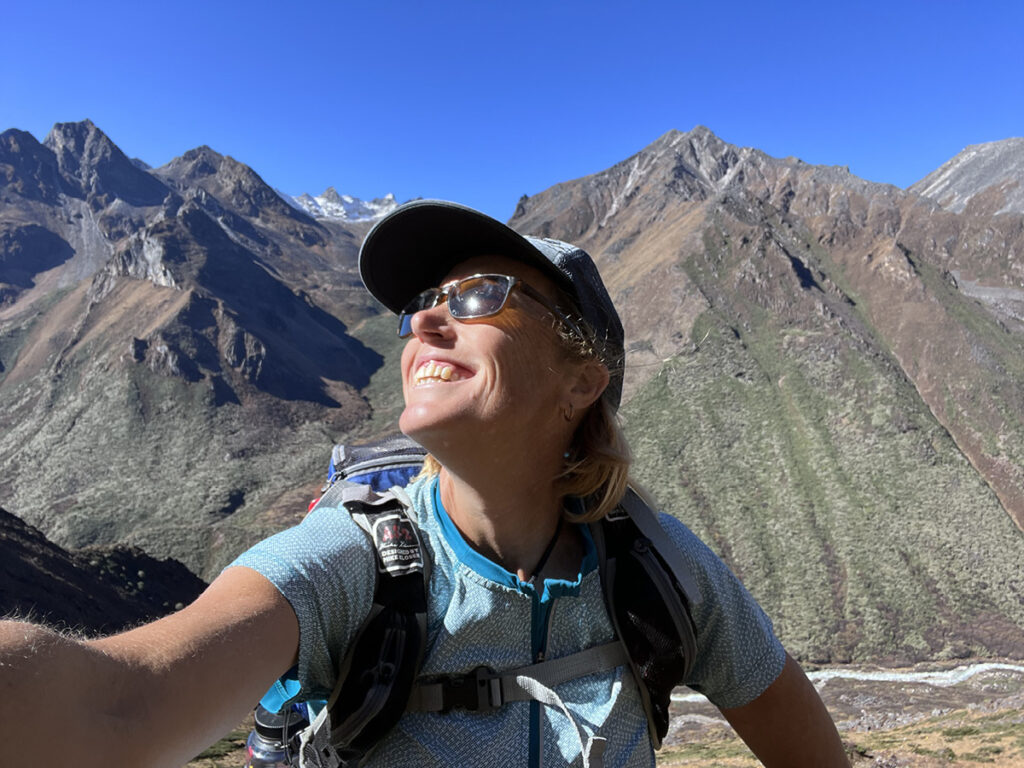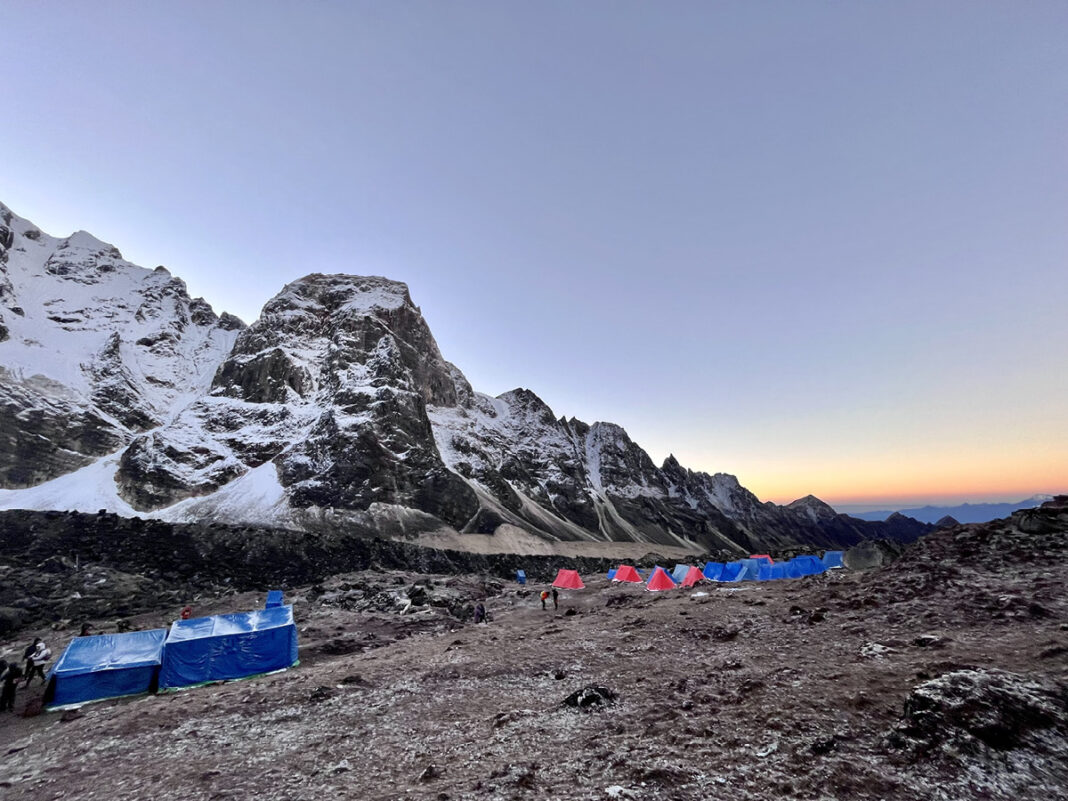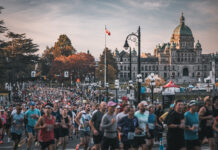I reach the highest point of the Snowman Race late on day three. Standing atop the 5,490 m (18,000 ft.) Gophu La Pass in the fading light, I can see Gangkhar Puensem, the world’s tallest unclimbed mountain, and just beyond that, Tibet.
I’m deep in the Bhutanese Himalayas in a place few have been. The lack of oxygen makes my brain fuzzy and my vision clouded, but I am acutely aware of the beauty all around. It takes me six hours to cover the last 15 kilometres in one of the most remote corners of the world, and I’m alone for most of it. At this altitude, every step takes effort, but I’m rewarded for my continual forward motion by making it to the pass before dark. For the last hour, I follow snow leopard prints and have to remind myself: This is real, Nicki. All of this is real.
I’m part of a team of 29 international and Bhutanese ultramarathon runners invited to compete in what is now the world’s highest ultramarathon. This is no ordinary event. The King of Bhutan conceived the race as an audacious way to tell the world that climate change is disproportionately impacting the Himalayan glaciers in the country, the downstream ecosystems below, and the people who call Bhutan home. We run through valleys and villages, meeting those most affected, and then sleep in tents under the clear night sky in remote camps set up by local adventure companies.

I’ve been curious about Bhutan for many years. The stories of its pristine and mystical landscape, unexplored Himalayan peaks (mountaineering is forbidden), and gross national happiness caught my interest. When I heard the King commissioned a mountain race to bring awareness to climate change, I immediately applied. I’ve watched our own glaciers in the Canadian Rockies retreat over the nearly thirty years I’ve lived here, so this is not some abstract problem in a faraway place. This race combined all my loves—travelling, running, and mountains—and so it was a no-brainer.
Trail runners tend to be deeply connected to the wild places in which they run and are passionate about preserving them. We pay attention to the weather, the terrain, the smells, and the sounds. These wild places are necessary for our sanity, and we empathize with those who also draw life from them. The King figured that if we came and ran in his mountains, we’d want to help protect them too. He was right.
Bhutan is a tiny country in the eastern Himalayas with a population of under a million. It values gross national happiness, responsible tourism, and sustainable development. Bhutan has promised to keep 65 per cent of its land under forest canopy forevermore, making it one of the three countries in the world to be carbon negative. The air is thin, but delicious, as if produced by the planet’s most powerful air filter. However, Bhutan is sandwiched between the two biggest polluters—India and China—and its people are threatened by the climate impacts caused by others.
The race is named after the Snowman Trek, known to be one of the most arduous, yet stunning journeys in the Himalayas. It’s more ancient trade route than trail, with shoe-sucking mud and tricky footing, better suited to yaks than people. But the biggest adversary is the altitude. The rule of thumb for high-altitude pursuits is to sleep no more than 300 metres higher than you did the night before.
Our night one camp, at almost 5,000 m, was 2,700 m above the start line (nine times recommended). It was a brutal way to kick off the 205-kilometre race, and it set the tone for what was to come.
Back on Gophu La Pass, I still have 20 kilometres to reach the third overnight camp. I have been racing for two and a half days above 4,000 m and by now, ten of my friends have succumbed to acute mountain sickness (AMS).
My body seems to be holding together but staying in this race is precarious. AMS does not care if you are elite or experienced, it only cares if you are adapted to the thin air, or lucky. Having just spent two weeks trekking in Nepal, I am both. But still, everything is more difficult up here — eating, breathing, even thinking.
I find two fellow athletes on the pass, and we decide to stick together for improved safety and morale. We don’t have a lot of daylight left and we all need more oxygen, so despite those incredible views, we don’t linger.
The sun sets shortly after we begin descending, the temperature plummets into negative double-digits and a heavy fog comes in like a tsunami. We stumble down the broad valley, navigating by the line on our GPS for what seems like forever. I remind myself that these difficult moments are the price we pay for the incredible ones.
Just before 10 p.m., after almost 16 hours of effort, most of which was deprived of oxygen, we reach camp.
Two days later, I run out of the mountains and proudly cross the finish line in Chamkhar in front of thousands of school children and locals. The noise of the crowd is jarring after five days of silence, but I relish the celebration.
I’ve raced many of the world’s hardest ultramarathons, but I’ve never done anything like this—not this high, this hard, or this risky. Often, in ultramarathon running, we say that “just finishing” is what matters. But this race was about showing up. And I’ve never done a race that carried as important a message: that we need to do everything we can to preserve our wild places, natural areas, and ecosystems, particularly in Bhutan. Technically we came to compete, but we left as ambassadors of the country and climate action. Bhutan is one of the last barely touched, pristine places in the world, and I hope it stays that way.
You May Also Like Running
Photography by Nicki Rehn

Read This Story in Our 2023 Inspiration Issue
Read about our 2023 Canada’s Top Fitness Instructors – our top 30 from across Canada! How to Train Smarter in 2023, Yoga Nidra for What Ails You, Racing the World’s Highest Ultramarathon, our favourite plant-based recipes and more!














